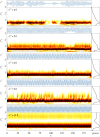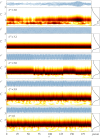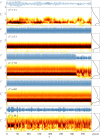Branch/mode competition in the flow-induced vibration of a square cylinder
- PMID: 29986915
- PMCID: PMC6048583
- DOI: 10.1098/rsta.2017.0243
Branch/mode competition in the flow-induced vibration of a square cylinder
Abstract
The flow-induced vibration response of a square cross-sectional cylinder with low mass and damping ratio is analysed using continuous wavelet transforms (CWT) for three representative angles of attack of the cylinder to the incoming flow. The amplitude and frequency responses over a range of flow velocities map out multiple regimes (branches) of oscillation. Analysis of the time-frequency domain for boundary regions between branches using CWT reveals intermittency at the synchronization region boundaries as well as mode competition at branch boundaries. Complementary recurrence analysis shows that periodic dynamical states are interrupted by chaotic bursts in the transition regions around the higher branch at an angle of attack of α = 20° (a new branch first observed by Nemes et al. (2012 J. Fluid Mech.710, 102-130 (doi:10.1017/jfm.2012.353))), supporting the CWT-based frequency-time analysis.This article is part of the theme issue 'Redundancy rules: the continuous wavelet transform comes of age'.
Keywords: bluff body; flow-induced vibration; fluid–structure interaction; wavelet.
© 2017 The Author(s).
Conflict of interest statement
We declare we have no competing interests.
Figures











References
-
- Wang Z, Du L, Zhao J, Sun X. 2017. Structural response and energy extraction of a fully passive flapping foil. J. Fluids Struct. 72, 96–113. (10.1016/j.jfluidstructs.2017.05.002) - DOI
-
- Nemes A, Zhao J, Lo Jacono D, Sheridan J. 2012. The interaction between flow-induced vibration mechanisms of a square cylinder with varying angles of attack. J. Fluid Mech. 710, 102–130. (10.1017/jfm.2012.353) - DOI
-
- Blevins RD. 1990. Flow-induced vibration, 2nd edn Malabar, FL: Krieger.
-
- Naudascher E, Rockwell D. 2005. Flow-induced vibrations: an engineering guide. New York, NY: Dover.
-
- Païdoussis MP, Price S, De Langre E. 2010. Fluid–structure interactions: cross-flow-induced instabilities. Cambridge, UK: Cambridge University Press.
LinkOut - more resources
Full Text Sources
Other Literature Sources

